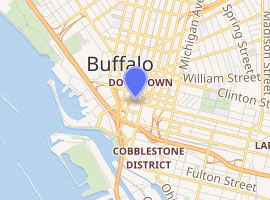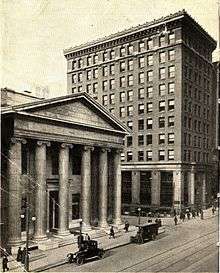Fidelity Trust Building
The Fidelity Trust Building, also known as Swan Tower, is a 160,000-square-foot (15,000 m2)[1] commercial Renaissance Revival office building located at 284 Main Street in the Joseph Ellicott Historical District (also called the Downtown Historic District) in downtown Buffalo, New York.
| Fidelity Trust Building | |
|---|---|
Fidelity Trust Building (Swan Tower), in Buffalo, New York | |

| |
| General information | |
| Status | Complete |
| Type | Office |
| Architectural style | Renaissance Revival |
| Location | 284 Main Street, Buffalo, NY, United States |
| Completed | 1909 |
| Renovated | 1926 |
| Owner | Ellicott Development Co. |
| Technical details | |
| Floor count | 11 |
| Design and construction | |
| Architect | Green & Wicks (1909) E. B. Green (1926) |
History
The site of the current building was once referred to as "The Weed Block", (located at Main & Swan) and was built in 1857. The block was home to Millard Fillmore's law office and other prominent Buffalo businessmen.[2] In May 1893, John J. Albright, along with George V. Forman, John Satterfield, and Franklin D. Locke, founded The Fidelity Trust and Guaranty Company of Buffalo, New York.[3] The block was demolished in 1901 to make room for the Fidelity Trust Building.[2]
In 1909, the officers of the Fidelity Trust company commissioned Green & Wicks to build the Fidelity Trust Building. Anson Goodyear described George V. Forman in the following way: "every morning left his house at a certain hour and met George Williams at his house just above North Street, to walk to the Fidelity Building together. Mr. Forman boasted a very prominent corporation and leaned backward to achieve his balance. Mr. Williams was emaciated and bent forward to achieve his. It was a procession on which people checked their watches."[2] In December 1925, the Fidelity Trust Company, with $35 million in assets, merged with Manufacturers and Traders Bank, founded in 1856, with $64 million in assets, under the new name Manufacturers and Traders Trust Company. The $100 million company was headed by Fidelity's President, 36-year-old Lewis G. Harriman. Harriman and a group of investors including A. H. Schoellkopf and James Forrestal, who would become the first United States Secretary of Defense, owned enough shares to control both Fidelity and M&T.[4]
In 1926, the building was expanded with the addition of the west wing. E. B. Green completed the addition.[2] The Fidelity Trust Building is adjacent to the White Building, a double sided building facing both Main and Erie streets, at 298 Main Street.[5]
Subsequent use
The building was later called the M&T Building, and later still the NFTA Building. In 2011, the building was referred to by the owner since 1989, Ellicott Development Co., as "Swan Tower".[2]
Features
The exterior of the building features many decorative details including:[2]

- Leaf-and-dart molding with "F" (for Fidelity) carved in stone
- Protruding cornice
- Block modillions
- Egg-and-dart molding
- Dentil molding
- Volutes in Roman Ionic columns
- Bay leaves in spandrels
- Above the entrance has fluted end brackets with guttae and dentils support broken pediment
The interior of the building also features decorative details including:[2]
- Plaster ceiling ornamentation with Arabesques
- Corinthian capitals
- Brass acanthus vines and flowers
- Brass guilloche
References
- "Swan Tower". ellicottdevelopment.com. Retrieved 28 October 2015.
- LaChiusa, Chuck. "Fidelity Trust Bank Building / Swan Tower". buffaloah.com. Retrieved 28 October 2015.
- Eck, Susan. "The Marine: by any other name and address". wnyheritagepress.org. Archived from the original on 11 November 2013. Retrieved 20 September 2015.
- "M&T Bank Celebrates 150 Years". mandtbank.com. Retrieved 20 September 2015.
- "White Building". preservationready.org. Retrieved 28 October 2015.